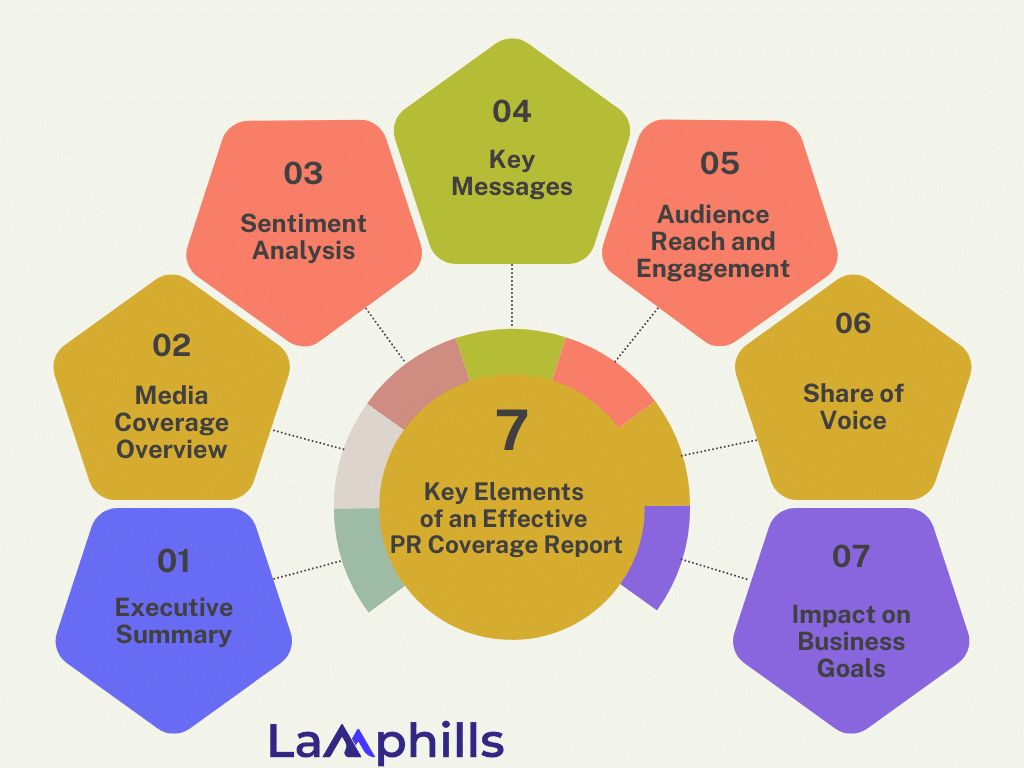When I first started in public relations, one of the most difficult responsibilities was generating PR coverage reports that successfully highlighted the worth of our work. I remember spending hours gathering data and attempting to convey it in a way that was both comprehensive and accessible. Over time, I created a structure that not only streamlined the process but also increased its impact. In this post, I’ll show you how to build an excellent PR coverage report, including tips and methods that go beyond the basics. Whether you’re new to public relations or trying to improve your reporting skills, this guide will provide vital insights to help you succeed.
What is a Public Relations Coverage Report?
A public relations coverage report is a detailed document that analyzes and evaluates the media coverage that a company or organization has received during a certain period. It comprises information regarding the coverage’s reach, tone, and impact, which aids in measuring the efficacy of PR tactics and justifying public relations investments.
I remember the first time I gave a PR coverage report to our executive team. By clearly demonstrating the effectiveness of our media efforts, we gained increased funding for future campaigns, greatly boosting our public relations endeavors.
Key Takeaways
- Creating detailed PR coverage reports is crucial for demonstrating the value of your PR efforts.
- Utilizing media monitoring tools is essential for capturing a complete picture of your media presence.
- Analyzing the sentiment of media coverage (positive, negative, neutral) is vital for understanding public perception.
- Employing a PR Coverage Report Template can streamline the reporting process, ensuring consistency and thoroughness.
Benefits of Good Public Relations Coverage
Public relations (PR) is an effective instrument in your marketing plan. Securing coverage in media publications that your target market reads, watches, or listens to can help your business reach its growth objectives by improving brand awareness and managing your reputation, as well as generating inquiries for your products and services.
Here are five main advantages of obtaining PR coverage for your company, including a few that you may not have considered before.
#1. Increase brand awareness
Brand awareness is much more than just consumers recognizing your company’s name, though it is obviously important, as we will explain later. Securing frequent press coverage in prominent magazines will provide potential customers with a thorough picture of your business. This could include your company’s beliefs, the products and services it provides, your team’s skills, and its market position. All of these factors contribute to potential client’s trust in your organization and their willingness to invest in your products or services.
#2. Drive Traffic to Your Website
When potential customers learn about your brand through public relations coverage, they are more likely to use a search engine to find your firm. Rather than competing with your competitors in search results for keywords related to your products and services, these potential clients have a more direct path to your website, increasing the likelihood that you will receive online traffic and inquiries. Furthermore, with online press coverage, there may be an opportunity to incorporate a link to your website, which is an excellent approach to increase traffic to your company’s website.
#3. Unlock the Untapped Potential in Your Industry
Not every potential consumer will use Google to look for the items or services they require. Furthermore, some clients will be aware of the problem but unsure of the remedy, making it harder for them to look for what they need online. Finding an article that speaks to their requirements and promotes a product or service that will provide the solution is an effective strategy to create leads that you might otherwise overlook.
#4. Enhance your credibility
Promoting the media coverage your organization receives is an excellent strategy to boost its reputation. It implies that you are an expert in your industry and are respected by media outlets that your target audience is already familiar with and trusts. Consider including a ‘as seen in’ banner on your website to highlight media in which your brand has appeared (subject to the relevant rights licenses). This is also an excellent feature to include in pitches, presentations, and proposals given to potential consumers.
#5. Change the perception of your brand
Public relations is more than just recruiting new customers; it may also help to strengthen your company’s relationships with existing and past customers. Perhaps your target demographic has an outdated view of your brand. Perhaps they are unaware that you have introduced new products and services in recent years, or that you have made innovative changes to how you work. Securing PR coverage is an excellent approach to spreading the word and opening up new opportunities within and outside of your present consumer base.
Key Elements of an Effective PR Coverage Report

#1. Executive Summary
Begin with a succinct description of the report’s main findings and highlights. This section should include a summary of the total media coverage and impact.
Example: “In the first quarter of 2024, our public relations efforts resulted in 150 media mentions, reaching an estimated 2 million people. Positive sentiment dominated the coverage, with 85% of pieces expressing good views of our brand.”
#2. Media Coverage Overview
Provide a full summary of every media coverage, including:
- Total Mentions: The number of times your brand has appeared in the media.
- Media Types: A breakdown of print, online, television, radio, and social media.
- Top Publications: A list of the top publications or channels that have covered your brand.
According to Cision, 68% of public relations professionals utilize media monitoring tools to track coverage on numerous platforms.
Using a thorough media monitoring platform enabled us to gather mentions that we would have otherwise missed, resulting in a more complete picture of our media footprint.
#3. Sentiment Analysis
Examine the tone of the coverage to see if it was good, negative, or neutral. This helps to understand public perception and identify areas for improvement.
For sentiment analysis, use platforms such as Meltwater, Brandwatch, and Hootsuite Insights.
Example: “Among the 150 media references, 120 were good, 20 were neutral, and ten were negative. The positive coverage focused on our recent product introduction and customer service excellence.”
#4. Key Messages
Identify and evaluate the primary messages presented in media coverage. Determine whether these messages are consistent with your PR aims and brand positioning.
Example: “The key messages during this period focused on our innovation in sustainable products, customer-centric approach, and market leadership.”
#5. Audience Reach and Engagement
Assess the reach and engagement of media coverage to determine its influence on your target audience.
Metrics to Include:
- Audience Reach: Estimated number of viewers for the coverage.
- Engagement: Includes social media likes, shares, comments, and other types of interaction.
- Website Traffic: Media mentions generate referral traffic to your website.
HubSpot discovered that brands that actively follow and evaluate media coverage experience a 20% increase in website traffic.
#6. Share of Voice
Comparing your media coverage to that of your competitors will help you understand your industry share of voice.
Best Practices:
- Monitor competition mentions along with your own brand.
- Determine the emotion and reach of competition coverage.
- Look for ways to expand your share of voice.
Example: “Our brand achieved a 25% share of voice in the industry, surpassing our closest competitor by 5%.”
#7. Impact on Business Goals
Link media coverage to specific company goals and KPIs to illustrate the effectiveness of public relations activities.
Metrics to Consider:
- Sales Increases: Link media coverage to sales statistics to demonstrate direct impact.
- Brand Awareness: Conduct surveys or brand studies to track changes in awareness.
- Lead Generation: Monitor leads and inquiries resulting from media coverage.
Demonstrating how a successful PR campaign resulted in a 15% increase in sales for a new product line helped justify the company’s sustained PR spending.
The Importance of Templates in PR Coverage Reporting
A PR Coverage Report Template can help you efficiently organize and deliver your findings. This template ensures uniformity and thoroughness, allowing you to successfully express the effects of your public relations initiatives.
If you intend to create your own PR reports, Word and Excel are common solutions, however, they are not as flexible as you would like. Some PR professionals want a more design-focused template, so they utilize PowerPoint or Canva.
Regardless of the format, here’s a template for what you should include.
- A concise summary of the period’s work: Reiterate the major PR campaign aim and demonstrate how the month’s work has brought you closer to attaining it. For example, if your PR campaign aims to raise brand awareness, you should instantly disclose an increase in positive customer sentiment for the month. The closer you can link your public relations efforts with the subsequent sales or brand awareness, the better.
- Complete coverage for the month: Include a link to each article, blog post, social media mention, or video. Make it easy for the client to get to the resulting coverage for a deeper look. Include screenshots from the coverage to make the PR campaign report more visually appealing.
- Key metrics by media outlet: Include relevant analytics for each media mention, such as the outlet’s projected monthly reach.
Read Also: What is Share of Voice? A Comprehensive Guide to Measuring Your Brand’s Market Presence
- The estimated value of media placement: Provide an estimated value for each media mention in public relations. Agencies prefer to use different measurements, so choose the most appropriate for you. Some of the measurement options include:
- The AVE assessment compares the article’s worth to the cost of an ad in the same media outlet.
- This leads to an increase in your client’s website traffic.
- Any positive changes detected by your media monitoring techniques, such as increased share of voice (SOV), customer sentiment research, and social media engagement.
- Other work: You can include a list of any additional PR work you’ve done this month, such as new press releases, an updated online press room, analyst briefings, or white papers.
- Next steps: To put your clients at ease, let them know you already have a strategy for next month. Briefly discuss your next steps for the coming weeks.
How Lamphills Can Help
Lamphills specializes in media and public relations techniques that help your brand get attention and reputation. Our expertise in developing comprehensive PR coverage reports can assist you in communicating the value of your PR efforts to stakeholders. Utilizing our services ensures that your brand is accurately represented and that your public relations initiatives are data-driven and impactful.
Conclusion
Creating an excellent PR coverage report is critical for showcasing the worth of your PR efforts and fine-tuning your tactics. Following the techniques mentioned in this article will allow you to develop detailed, analytical reports that showcase your successes while also identifying areas for improvement. Have you had trouble reporting on public relations coverage? Which tactics have you discovered to be the most effective? Let’s continue the conversation in the comments section.
Related Articles
- Where to Send Press Release in 9 Steps (My Expert Tips)
- Elevate Your Brand’s Marketing Strategies With PR Boxes
- Free PR Tools: Top 10 Free PR Gems That Put Paid Tools to Shame
- Bad PR Examples & Lessons You Should Learn (Expert Tips)
- What a PR Strategist Really Does: (+ Free Helpful Tips)






